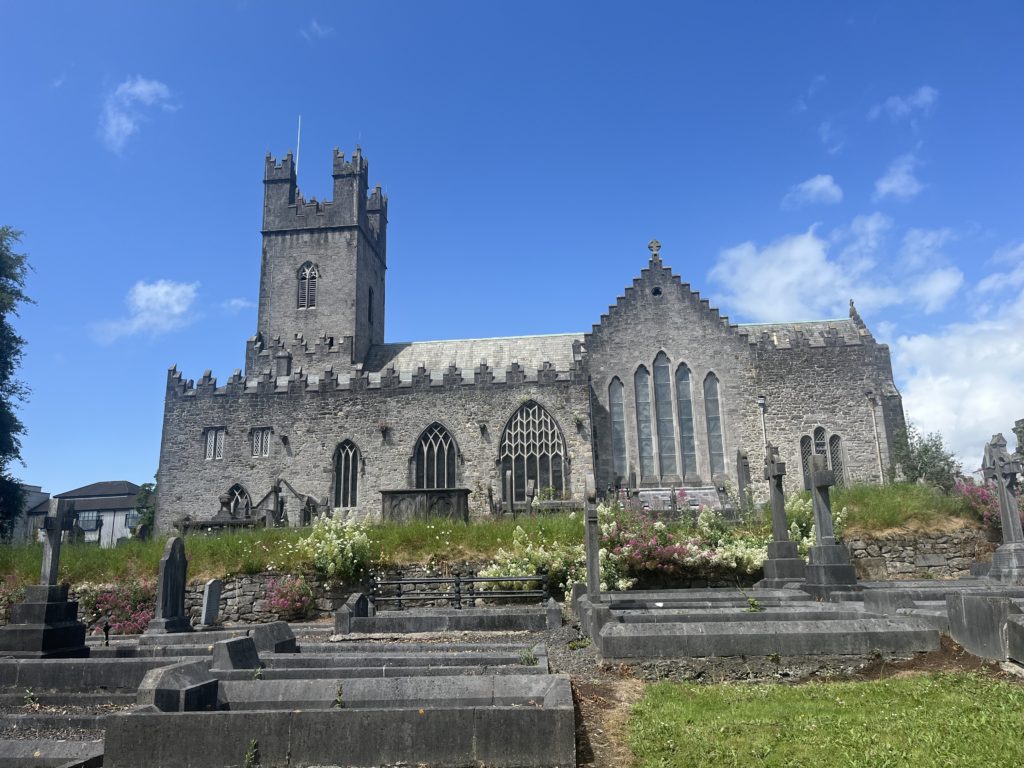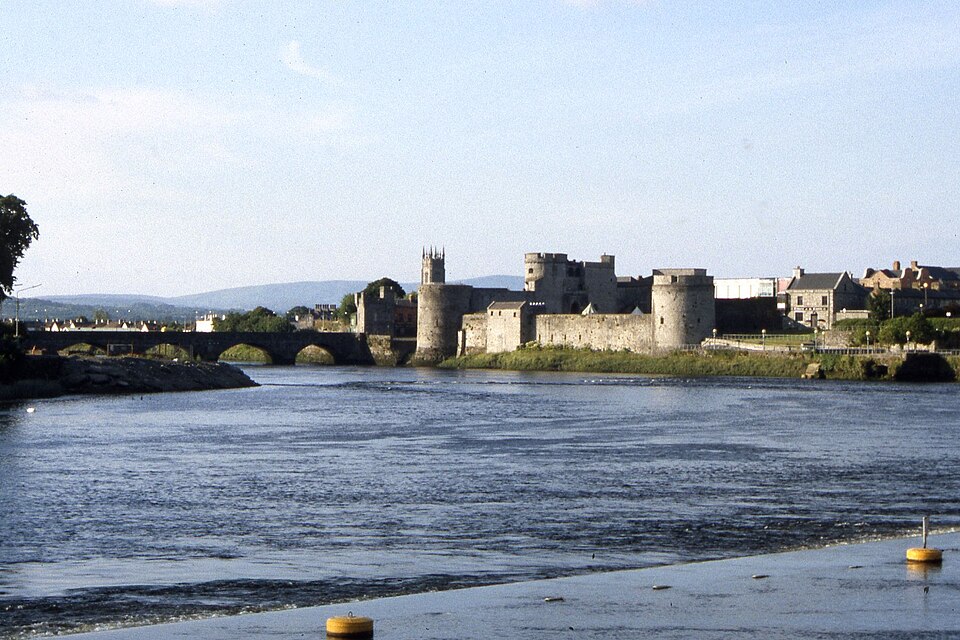FOR over 850 years, holy water has blessed the faithful at St Mary’s Cathedral, Limerick.
Founded in 1168, this is Limerick’s oldest building still in daily use. Standing on King’s Island, it has witnessed more than eight centuries of the city’s turbulent history — from sieges to reformations, and not forgetting battles, treaties and civil upheavals.
The cathedral’s sturdy west door is said to have been carved from a single oak tree, and the tower’s eight bells have tolled for centuries over the River Shannon.
Inside, ancient misericords, memorials and stone carvings evoke the faith and craftsmanship of generations. Today it remains an active parish church and concert venue.
To be fair, Limerick is not widely known for its cathedral. Rather, it is seen as the city of the Cranberries and of Thomond Park, of Terry Wogan, Richard Harris, of Angela’s Ashes, The Rubberbandits and our President, Michael D. Higgins (for the next few days).
To contemplate this journey from war-torn settlement on the banks of the Shannon to today’s vibrant metropolis, fetch up at the Locke Bar, as much a riverside institution as the cathedral.
 St Mary's Cathedral in Limerick (Pic: Tourism Ireland)
St Mary's Cathedral in Limerick (Pic: Tourism Ireland)The a thatched-roofed tavern features food that is a cut above standard pub fare: seafood chowder, Limerick ham hock, and mussels in cream and cider. (lockebar.com)
Limerick, city and county, has a long history. Human habitation can be traced hereabouts to 3500 BC. Thereafter, the usual suspects arrived. The Vikings fetched up around 922 and settled at the lowest crossing point of the River Shannon where it meets the sea.
Hot on the heels of the Danes and co. came the Normans in the 12th and 13th centuries, followed a few years later by those two foremost agents of discontent in Ireland, Edward the Bruce and Oliver Cromwell.
No wonder the city’s official motto is Urbs antiqua fuit studisque asperrima belli, which means, as most Irish Post readers will know, “An ancient city well versed in the arts of war.”
This motto is displayed on the city’s coat of arms and originates from a description of Carthage in Virgil’s Aeneid.
But all that history has led to one fascinating city.
As you stand on Sarsfield Bridge and watch a hundred swans swim effortlessly down the Shannon towards the Atlantic, the gaunt contours of King John’s Castle are etched out against the western horizon. Some 800 years old, it’s a quintessential example of Anglo-Norman architecture.
Located on King’s Island along with the rest of the remains of Limerick’s medieval centre, the castle boasts an impressive visitor centre. From the ramparts, views of the Shannon are naturally panoramic — if you wanted to protect a city in Norman times, a good view of the hinterland was a prerequisite.
If you visit a number of cathedrals every year, this one should be top of your list.
The Treaty Stone on Thomond Bridge is one of the landmarks of Limerick. The Treaty of Limerick, which ended the Williamite War in Ireland, was reputedly signed by Patrick Sarsfield and Godert de Ginkell, a Dutchman, on the Treaty Stone — an irregular block of limestone which once served as a mounting block for horse riders.
The use of “Patrick” greatly increased as Sarsfield’s fame grew, and he is generally seen as having popularised the name. Godert, on the other hand, never really caught on.
Limerick’s main thoroughfare, O’Connell Street, runs southwards to the Crescent, a beautiful collection of elegant Georgian buildings, now largely occupied by financial institutions.
Limerick City Gallery of Art (limerick.ie/gallery), in the historic Carnegie Building on the grounds of the People’s Park, has some stunning collections of both contemporary art and sculpture.
 King John's Castle in Limerick
King John's Castle in LimerickIt is home to a permanent collection of Irish art, featuring works from the early 18th to 20th centuries. The gallery houses the National Collection of Contemporary Drawing, founded by the artist Samuel Walsh in 1987.
For sporting enthusiasts, Limerick has, of course, Thomond Park.
The famous rugby stadium offers behind-the-scenes tours that include visiting the Munster Rugby dressing room, pitch side, and the post-match interview area, along with an interactive museum experience about the club’s history. Tours are available Monday to Friday, and on Saturdays for pre-booked groups, and typically last approximately one hour and fifteen minutes (thomondpark.ie/museum-tours).
Having sated yourself with stories of mauls, scrums and up-and-unders, you’ll likely fancy a wander along the Shannon. The Curragower Bar & Kitchen gastropub in the heart of the city’s Medieval Quarter not only offers excellent food but also a magical view of King John’s Castle reflected in the water.
It’s the perfect backdrop for a pint and seafood pie — chunky pieces of salmon, hake and prawns.
Another favourite is House Limerick. Set in a grand Georgian building on Howley’s Quay, House Limerick brings a hint of Dublin polish to the Shannon’s edge.
Inside, it’s all high ceilings, velvet banquettes and candlelit corners, while the terrace offers one of the city’s best river views. The menu leans towards Irish-European comfort food done with flair — think seafood linguine, roast hake, and Guinness-braised beef.
Foyne’s Flying Museum, Co Limerick
On July 9,1939, Pan Am's luxury flying boat, the Yankee Clipper landed at Foynes. This was the first commercial passenger flight on a direct route from the USA to Europe, just at the start of World War II.
Foynes had become the pivotal point for air traffic between North America and Europe. Back then flying was a more rigorous business than today (well, not counting some budget airlines) so it's no wonder that Irish coffee was invented here — to fortify the doughty air travellers. Coffee, cream, whiskey and sugar usually did the trick for even the most nervous of passengers.
The Foynes Flying Boat Museum recalls this era with exhibits and illustrations, a 1940s style cinema and the original terminal building. Photos, paraphernalia, a B314 Flying Boat replica, films — and of course plenty of Irish coffee — make this an intriguing museum.
www.flyingboatmuseum.com
Limerick Soviet
Limerick Soviet was a short-lived self-declared workers’ republic that briefly existed in April 1919. After British authorities imposed martial law in Limerick city — following the death of trade unionist Robert Byrne, who had been shot during a rescue attempt — local workers, led by the Limerick United Trades and Labour Council, declared a general strike.
They took control of the city’s administration for nearly two weeks, printing their own currency stamped “The Limerick Soviet,” controlling food prices, and issuing permits for movement in and out of the city. Banners reading “Workers of the World Unite” hung from the city’s buildings.
Although the “soviet” was peaceful and well-organised, it ended on 27 April 1919, when union leaders, under pressure from Dublin and London, called it off.
While short-lived, the Limerick Soviet became a powerful symbol of Irish labour activism and is often referred to as Ireland’s first socialist republic, predating the later radical ferment of the 1920s.

